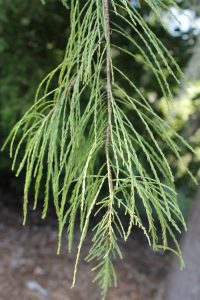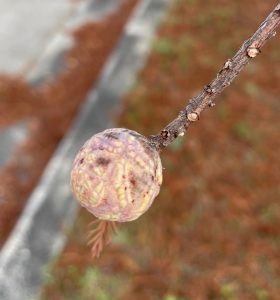
Cypress trees (Taxodium distichum) are in my top five favorite plants list, for many reasons. They have an incredible structure, with a wide base for support and up-reaching knees (also known as pneumatophores) for oxygen exchange on both land and water. They have a nearly perfect pyramidal shape overall, making them one of the most wind-resistant species in the landscape. Strong winds whip circularly around their flexible branches, and they stay upright.

Depending on which source you check, there are either two species or two varieties of cypress common to north Florida. Pond cypress (Taxodium ascendens or Taxodium distichum var. imbricarium) is typically found in stiller, standing water, while bald cypress is common in river systems and swamps with moving water. Bald cypress (needles featured in banner photo above) are flat, soft, and featherlike, while pond cypress needles are in a more three-dimensional and overlapping orientation.
In the spring and summer, cypress needles are a brilliant shade of bright green, and during the fall they provide rare and brilliant copper color to our local forests. In winter, these give way to a carpet of deep orange as needles drop from the tree. A cypress tree’s reddish peeling bark adds interest to the winter landscape.

As a conifer, the cypress also produces fascinating little 1″ round cones this time of year. A wide variety of birds and squirrels feed on the seeds, but any cones not eaten can float downriver and take root to become new trees. Cypress trees have long been prized for their beautiful, rot-resistant wood and long-lasting mulch, but always check the source before purchasing. The unsustainable harvest of wild cypress trees from wetland ecosystems can (and has) caused damage over the years. Cypress trees play an important role in the environment, stabilizing river banks, absorbing floodwaters, and providing habitat to birds and fish. Eagles and hawks use the top branches for nesting, while ducks, catfish, and amphibians nest in hollow trunks and logs of the trees.
While native to wetland areas, cypress trees have no problems growing in well-drained soil. Be aware that their roots may shoot up “knuckles” if not full grown “knees,” so give the tree a wide mulched berth and do not mow too close, to avoid root damage. Cypress can grow to massive heights of 100-150’ tall and live up to 600 years, but it is rare to see any that old or tall since most old-growth cypress trees were logged in the 19th century.
 1
1
